
|
The Settlers of the Stone Age A game by Klaus Teuber Published by Mayfair Games, Inc. Players: 3 or 4 Time: 90 minutes Reviewed by Susan Rozmiarek |
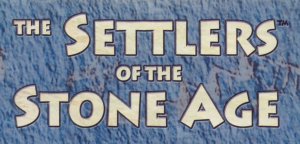
|
The Settlers of the Stone Age,
the English language version of Abenteuer
Menschheit from Kosmos, is the latest addition to the
ever-growing Settlers of Catan
series. This is a stand-alone game that depicts the wanderings of
early humans as they spread from Africa and out across the rest of the
world, adapting and developing as they went. It uses the basic and
familiar system of The Settlers of
Catan combined with some new and unique mechanisms as befitting
the theme.
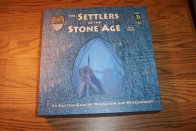 Components:
Critics of the components of some of Mayfair's earlier games should be
somewhat mollified. With the exception of the box art and corresponding
cover of the rules, this game is a replica of its German counterpart.
In all honesty, I don't care for the art on the box of either
edition. The brown German box is rather ugly to me, and the
Mayfair edition's box is too plain and "blue." Some eye-catching
contrasting colors would have been nice. This a matter of taste
and a minor quibble, though, as it is the contents of the box that
really matters. Here, the game does not disappoint.
Components:
Critics of the components of some of Mayfair's earlier games should be
somewhat mollified. With the exception of the box art and corresponding
cover of the rules, this game is a replica of its German counterpart.
In all honesty, I don't care for the art on the box of either
edition. The brown German box is rather ugly to me, and the
Mayfair edition's box is too plain and "blue." Some eye-catching
contrasting colors would have been nice. This a matter of taste
and a minor quibble, though, as it is the contents of the box that
really matters. Here, the game does not disappoint.
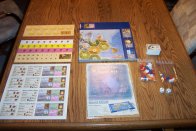 The board is very large with bright,
attractive graphics. It is a fixed board with the resource types and
production values printed on the board. The counters and player's aids
are on thick stock and the cards are of good quality. Each player
has a wooden set of bits in their color in the shape of campfires,
along with two little cylinders representing explorers and some cubes
for marking progress on the progress charts. Glossy, full-color
rules with many illustrations and a box insert that does a fairly good
job organizing the pieces rounds out an appealing presentation.
The board is very large with bright,
attractive graphics. It is a fixed board with the resource types and
production values printed on the board. The counters and player's aids
are on thick stock and the cards are of good quality. Each player
has a wooden set of bits in their color in the shape of campfires,
along with two little cylinders representing explorers and some cubes
for marking progress on the progress charts. Glossy, full-color
rules with many illustrations and a box insert that does a fairly good
job organizing the pieces rounds out an appealing presentation.
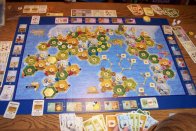 Game play: The map depicts the
continents of Africa, "Eurasia", America, and Australia, with land
bridges connecting Australia and America with Eurasia. The map is
composed of hexes of differing land types with a number that generates
a resource when it is rolled on the dice. The land types are hills,
plains, mountains, and forests, which produce meat, bones, flint, and
hides, respectively. There are 32 tribe counters that are placed
throughout the board on predetermined intersections. These come
in four colors, depending on which region on the board they are located
and they mark the spots where players may build camps. In
addition, there are four sets of exploration counters that are shuffled
and placed in marked locations around the perimeters of the
continent. These will be explained later.
Game play: The map depicts the
continents of Africa, "Eurasia", America, and Australia, with land
bridges connecting Australia and America with Eurasia. The map is
composed of hexes of differing land types with a number that generates
a resource when it is rolled on the dice. The land types are hills,
plains, mountains, and forests, which produce meat, bones, flint, and
hides, respectively. There are 32 tribe counters that are placed
throughout the board on predetermined intersections. These come
in four colors, depending on which region on the board they are located
and they mark the spots where players may build camps. In
addition, there are four sets of exploration counters that are shuffled
and placed in marked locations around the perimeters of the
continent. These will be explained later.
Players start with three camps (and an explorer if using the beginner's
setup) in Africa. A turn is essentially the same as in the
original Settlers consisting of:
- Roll for resource production: Hexes produce a resource of that type for players with a camp adjacent to it.
- Trade: Trade resources with other players or 3:1 with the "bank".
- Build: Or in this case, spend the resources doing a variety of things. These things are:
- Create an explorer: (1 hide and 1 meat) The explorer is placed on an intersection adjacent to one of its player's camps. Explorers do NOT collect resources for hexes to which they are adjacent.
- Move an explorer: (1 meat) A player can move an explorer up to two spaces (intersections) plus a bonus based on their progress on the food progress chart.
- Convert an explorer to a camp: (1 bone, 1 hide, 1 flint) A player can covert an explorer to a camp if it is resting on a tribe counter. The player replaces the explorer with one of his camps. If he has no camp left in his supply, he must use one of his camps already on the board in Africa or the camp of his choice if none remain in Africa. He also removes the tribe counter and places it in front of him. It is worth 1 victory point (VP). The first player to build a camp and receive a tribe counter in each of the four colors will receive the Expansion Card worth 2 VP. The second player to do the same will pick up the tribe counter of his choice from the board for 1 VP.
- Advance a progress marker: There are four progress tracks, one along each edge of the board. It costs various combinations of resources to advance along these tracks, getting progressively more expensive the further one goes. Two of the tracks, "clothing" and "construction", permit passage across certain spots (called "requirement boxes") on the board, including the land bridges between continents. Advancing along the "food" track allows explorers to move farther for each meat they spend. Each advancement along the "hunting" track allows a player to move either the Neanderthal or sabertooth tiger figure, the effect of which will be explained shortly. The player who gets to the top spot on any progress chart gets an "art" card worth 1 VP.
- The Neanderthal and sabertooth tiger figures: These work in similar fashion to the "robber" in the original Settlers of Catan. The Neanderthal can be placed on any hex in Eurasia or Africa, while the sabertooth tiger can be placed on any hex in America or Australia. When a player rolls a "7" with the dice on his turn, he must move the Neanderthal (not the sabertooth) to any hex in Eurasia or Africa and then may steal a random card from a player that has a camp adjacent to that hex. In addition, any player with more than 7 resource cards in their hand must discard half of them rounded down. The other way the Neanderthal and the only way the sabertooth tiger can be moved is for a player to spend the necessary resources and advance his marker one space on the hunting progress chart. He then gets to steal a resource card in the same manner. Any hex that has the Neanderthal or the sabertooth tiger on it will not produce resources when its number is rolled.
- Exploration Counters: The exploration counters come in four different sets (numbered I -IV) of 4 or 5 counters that correspond to four different regions on the board. These sets are shuffled and placed face down on designated spots on the peripheries of these regions. Each of these spots is next to a "requirement box" that is centered in the middle of a path bordering an outer hex. In the requirement box are two numbers that indicate how far a player must have advanced on the clothing and construction progress charts in order to pass along this path. As you get further away from Africa, the requirements grow steeper. If a player moves his explorer past this box, he picks up the corresponding counter and executes the action depicted on the counter's hidden side. Each set of tiles shows one of the following pictures:
- The Neanderthal and sabertooth tiger: The player chooses one of these to move.
- A colored circle: The player takes the Adaptation Card that corresponds to the color of the circle. This card is worth 1 VP.
- A land hex: The player takes a desert counter and places it on one of the land hexes in Africa of the type depicted on the exploration tile. This hex is now a desert hex for the rest of the game and will produce no more resources.
The first player to reach 10 VP wins. In summary, victory points can be earned in the following ways:
- Building new camps (1 VP)
- Being the first (2 VP) or second (1 VP) to build a camp in all four regions of the board
- Being the first to get to the top of a progress chart (1 VP)
- Finding an adaptation counter through exploration (1 VP)
- Collecting the most exploration counters. (2 VP)
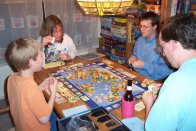 Commentary:
While the fundamental Settlers of
Catan system remains intact, The
Settlers of the Stone Age plays very differently and has a unique
feel to it. Unlike the original Settlers game where the
settlements you establish and develop remain static, in this game you
are constantly picking them up and moving them, in true nomadic
fashion. Hence, the hex types and numbers with which you get
resources will be changing, especially in the latter half of the
game. While blocking opponents' development with roads was a major
part of the original game, in Stone
Age this blocking ability is absent, since explorers can move
through the camps and explorers of other players. There is,
however, much competition for the optimal spots to build camps.
Commentary:
While the fundamental Settlers of
Catan system remains intact, The
Settlers of the Stone Age plays very differently and has a unique
feel to it. Unlike the original Settlers game where the
settlements you establish and develop remain static, in this game you
are constantly picking them up and moving them, in true nomadic
fashion. Hence, the hex types and numbers with which you get
resources will be changing, especially in the latter half of the
game. While blocking opponents' development with roads was a major
part of the original game, in Stone
Age this blocking ability is absent, since explorers can move
through the camps and explorers of other players. There is,
however, much competition for the optimal spots to build camps.There are many different paths to get victory points and at first they seem overwhelming. One can delay establishing camps and instead focus on moving up quickly on the progress charts and exploring, but this hastens Africa's changeover to desert and the player who hasn't built new camps will find his resource production declining at an alarming rate. Carefully balancing your development seems to be a key to success.
In our games, there seemed to always be a meat shortage at the start and soon thereafter a bone shortage. In the beginning, meat is crucial to get one's explorers moving. Once players have moved up some on the food progress chart and can move their explorers farther per meat spent, the shortage of meat eases somewhat. Bone now becomes crucial because one needs it for so many things- establishing new camps and moving up on all the progress charts. To add insult to injury, one of the exploration tiles in the first region is a plains hex, ensuring that one of the first African hexes to turn to desert will be a bone-producing one. Due to these shortages, the ability to trade 3:1 with the bank was used often in our games.
So what's not to like about The Settlers of the Stone Age? Well, it does retain a key characteristic of the original game that is often criticized, which is that a player's success can depend greatly upon random dice rolls. It does not have a mechanism built in like that in Die Siedler von Nürnberg or the Alexander the Great historical scenario that eases this problem. In most of our games of Stone Age (and Settlers of Catan), there has been a player who lost out on the resource rolls early on (despite good initial placements) and could never catch up, making for a long and miserable game for that player. In some games it seems like the dice defy all laws of probability.
Another potential problem is that the fixed board may limit replay value. After several plays, though, I do not yet feel like I've fully explored the game's possibilities.
Conclusion: The Settlers of the Stone Age should have great appeal to fans of The Settlers of Catan. For those like me who are looking for a fresh approach to the classic game, it provides a new theme with some interesting twists that give it a different feel. It is a worthy addition to the Settlers of Catan series.
| Other Web information: |
This page viewed
E-mail Ed Rozmiarek with questions or problems concerning this page.
Copyright © 2003, Ed Rozmiarek